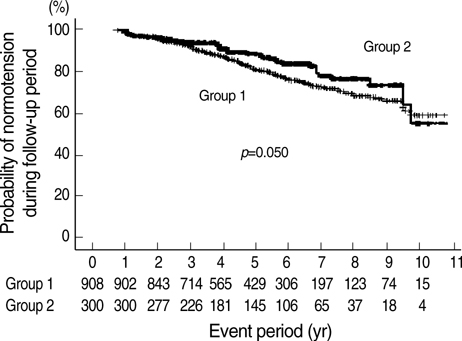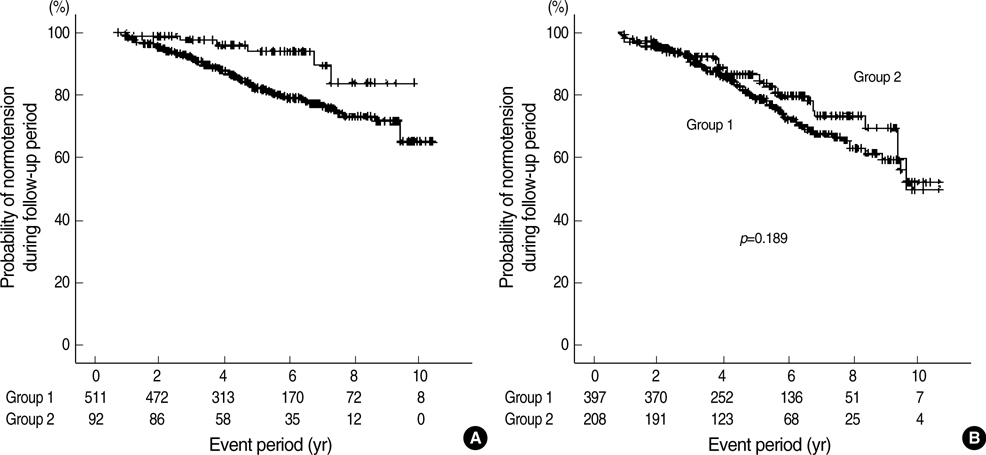J Korean Med Sci.
2009 Jan;24(Suppl 1):S50-S56. 10.3346/jkms.2009.24.S1.S50.
The Bilirubin Level is Negatively Correlated with the Incidence of Hypertension in Normotensive Korean Population
- Affiliations
-
- 1Department of Internal Medicine, Seoul National Univeristy College of Medicine, Seoul, Korea. mednep@snubh.org
- 2Department of Internal Medicine, Seoul National University Bundang Hosptial, Seongnam, Korea.
- 3Department of Internal Medicine, Hallym University College of Medicine, Chuncheon, Korea.
- 4Department of Family Medicine, Seoul National Univeristy College of Medicine, Seoul, Korea.
- 5Clinical Research Institute, Seoul National University Hospital, Seoul, Korea.
- KMID: 1778140
- DOI: http://doi.org/10.3346/jkms.2009.24.S1.S50
Abstract
- Reactive oxygen species have been known to be an important factor in the pathogenesis of hypertension. Bilirubin, one of the metabolites of heme degraded by heme oxygenase, is a potent anti-oxidant. We verified the effect of serum bilirubin level on the incidence of hypertension in normotensive subjects. We grouped 1,208 normotensive subjects by the criterion of the highest quintile value of serum bilirubin, 1.1 mg/dL. The incidence of hypertension was higher in group 1 with bilirubin less than 1.1 mg/ dL than in group 2 with bilirubin 1.1 mg/dL or more (186/908 vs. 43/300, p=0.018). The relative risk for hypertension was 0.71 (95% confidence interval, 0.51-0.99), p=0.048 in group 2 compared to group 1 by Cox's proportional hazard model. Among the groups stratified by gender, smoking, and liver function status, the group 2 showed a lower risk of hypertension in females and in non-smokers. In conclusion, a mild increase within the physiological range of serum bilirubin concentration was negatively correlated with the incidence of hypertension. The effect of bilirubin on the development of hypertension was more evident in females and in non-smokers.
Keyword
MeSH Terms
Figure
Reference
-
1. Kirkby KA, Adin CA. Products of heme oxygenase and their potential therapeutic applications. Am J Physiol Renal Physiol. 2006. 290:F563–F571.
Article2. Goodman AI, Quan S, Yang L, Synghal A, Abraham NG. Functional expression of human heme oxygenase-1 gene in renal structure of spontaneously hypertensive rats. Exp Biol Med. 2003. 228:454–458.
Article3. Sabaawy HE, Zhang F, Nguyen X, ElHosseiny A, Nasjletti A, Schwartzman M, Dennery P, Kappas A, Abraham NG. Human heme oxygenase-1 gene transfer lowers blood pressure and promotes growth in spontaneously hypertensive rats. Hypertension. 2001. 38:210–215.
Article4. Ndisang JF, Zhao W, Wang R. Selective regulation of blood pressure by heme oxygenase-1 in hypertension. Hypertension. 2002. 40:315–321.
Article5. Botros FT, Schwartzman ML, Stier CT Jr, Goodman AI, Abraham NG. Increase in heme oxygenase-1 levels ameliorates renovascular hypertension. Kidney Int. 2005. 68:2745–2755.
Article6. Pradhan A, Umezu M, Fukagawa M. Heme-oxygenase upregulation ameliorates angiotensin II-induced tubulointerstitial injury and salt-sensitive hypertension. Am J Nephrol. 2006. 26:552–561.
Article7. Vera T, Kelsen S, Yanes LL, Reckelhoff JF, Stec DE. HO-1 induction lowers blood pressure and superoxide production in the renal medulla of angiotensin II hypertensive mice. Am J Physiol Regul Integr Comp Physiol. 2007. 292:R1472–R1478.
Article8. Johnson RA, Lavesa M, DeSeyn K, Scholer MJ, Nasjletti A. Heme oxygenase substrates acutely lower blood pressure in hypertensive rats. Am J Physiol. 1996. 271:H1132–H1138.
Article9. Johnson RA, Lavesa M, Askari B, Abraham NG, Nasjletti A. A heme oxygenase product, presumably carbon monoxide, mediates a vasodepressor function in rats. Hypertension. 1995. 25:166–169.
Article10. Wiesel P, Patel AP, Carvajal IM, Wang ZY, Pellacani A, Maemura K, DiFonzo N, Rennke HG, Layne MD, Yet SF, Lee ME, Perrella MA. Exacerbation of chronic renovascular hypertension and acute renal failure in heme oxygenase-1 deficient mice. Circ Res. 2001. 88:1088–1094.11. Motterlini R, Gonzales A, Foresti R, Clark JE, Green CG, Winslow RM. Heme oxygenase-1-derived carbon monoxide contributes to the suppression of acute hypertensive responses in vivo. Circ Res. 1998. 83:568–577.
Article12. Kitiyakara C, Wilcox CS. Antioxidants for hypertension. Curr Opin Nephrol Hypertens. 1998. 7:531–538.
Article13. Reckelhoff JF, Romero JC. Role of oxidative stress in angiotensin-induced hypertension. Am J Physiol Regul Integr Comp Physiol. 2003. 284:R893–R912.14. Stocker R, Yamamoto Y, McDonagh AF, Glazer AN, Ames BN. Bilirubin is an antioxidant of possible physiological importance. Science. 1989. 235:1043–1046.
Article15. Pflueger A, Croatt AJ, Peterson TE, Smith LA, d'Uscio LV, Katusic ZS, Nath KA. The hyperbilirubinemic Gunn rats is resistant to the pressor effects of angiotensin II. Am J Physiol Renal Physiol. 2005. 288:F552–F558.16. Lanone S, Bloc S, Foresti R, Almolki A, Taille C, Callebert J, Conti M, Goven D, Aubier M, Dureuil B, El-Benna J, Motterlini R, Boczkowski J. Bilirubin decreases nos2 expression via inhibition of NAD (P)H oxidase: implications for protection against endotoxic shock in rats. FASEB J. 2005. 19:1890–1892.17. Sano K, Nakamura H, Matsuo T. Mode of inhibitory action of bilirubin on protein kinase C. Pediatr Res. 1985. 19:587–590.
Article18. Rajagopalan S, Kurz S, Munzel T, Tarpey M, Freeman BA, Griendling KK, Harrison DG. Angiotensin II-mediated hypertension in the rat increases vascular superoxide production via membrane NADH/NADPH oxidase activation. Contribution to alterations of vascular tone. J Clin Invest. 1996. 97:1916–1923.19. Novotny L, Vitek L. Inverse relationship between serum bilirubin and atherosclerosis in Men: A meta-analysis of published studies. Exp Biol Med (Maywood). 2003. 228:568–571.
Article20. Papadakis JA, Ganotakis ES, Jagroop IA, Jagroop IA, Mikhailidis DP, Winder AF. Effect of hypertension and its treatment on lipid, lipoprotein(a), fibrinogen, and bilirubin levels in patients referred for dyslipidemia. Am J Hypertens. 1999. 12:673–681.
Article21. Van Hoydonck PG, Temme EH, Schouten EG. Serum bilirubin concentration in a Belgian population: the association with smoking status and type of cigarettes. Int J Epidemiol. 2001. 30:1465–1472.22. White GL Jr, Nelson JA, Pedersen DM, Ash KO. Fasting and gender (and altitude?) influence reference intervals for serum bilirubin in healthy adults. Clin Chem. 1981. 27:1140–1142.
Article23. Zucker SD, Horn PS, Sherman KE. Serum bilirubin levels in the U.S. population: gender effect and inverse correlation with colorectal cancer. Hepatology. 2004. 40:827–835.
Article24. Suzuki H, Swei A, Zweifach BW, Schmid-Schonbein GW. In vivo evidence for microvascular oxidative stress in spontaneously hypertensive rats. Hydroethidine microfluorography. Hypertension. 1995. 25:1083–1089.25. Nicod L, Rodriguez S, Letang JM, Viollon-Abadie C, Jacqueson A, Berthelot A, Richert L. Antioxidant status, lipid peroxidation, mixed function oxidase and UDP-glucuronyl transferase activities in livers from control and DOCA-salt hypertensive male Sprague Dawley rats. Mol Cell Biochem. 2000. 203:33–39.26. Swei A, Lacy F, DeLano FA, Schmid-Schonbein GW. Oxidative stress in the Dahl hypertensive rat. Hypertension. 1997. 30:1628–1633.
Article27. Laursen JB, Rajagopalan S, Galis Z, Tarpey M, Freeman BA, Harrison DG. Role of superoxide in angiotensin II-induced but not catecholamine-induced hypertension. Circulation. 1997. 95:588–593.
Article28. Kumar KV, Das UN. Are free radicals involved in the pathobiology of human essential hypertension? Free Radic Res Commun. 1993. 19:59–66.
Article29. Frei B, Forte TM, Ames BN, Cross CE. Gas phase oxidants of cigarette smoke induce lipid peroxidation and changes in lipoprotein properties in human blood plasma. Biochem J. 1991. 277:133–138.30. Villard PH, Herber R, Seree EM, Attolini L, Magdalou J, Lacarelle B. Effect of cigarette smoke on UDP-glucuronyltransferase activity and cytochrome P450 content in liver, lung and kidney microsomes in mice. Pharmacol Toxicol. 1998. 2:74–79.31. Rhee MY, Na SH, Kim YK, Lee MM, Kim HY. Acute effects of cigarettes smoking on arterial Stiffness and blood pressure in male smokers with hypertension. Am J Hypertens. 2007. 20:637–641.32. Toth B, Yokoyama Y, Kuebler JF, Schwacha MG, Rue LW 3rd, Bland KI, Chaudry IH. Sex differences in hepatic heme oxygenase expression and activity following trauma and hemorrhagic shock. Arch Surg. 2003. 138:1375–1382.
Article33. Hong JS, Yi SW, Kang HC, Jee SH, Kang HG, Bayasgalan G, Ohrr H. Age at menopause and cause-specific mortality in South Korean Women: Kangwha Cohort Study. Maturitas. 2007. 56:411–419.
Article
- Full Text Links
- Actions
-
Cited
- CITED
-
- Close
- Share
- Similar articles
-
- Relationship Between Intracranial Aneurysm and Hypertension
- Interference of Bilirubin in Measurement of Uric Acid
- The Association between Low Serum Bilirubin and Carotid Atherosclerosis in Subjects with Type 2 Diabetes
- Observation of the Serum Uric Acid in Essential Hypertension
- A Study on the Food Habits, Nutrient Intake and the Disease Distribution in the Elderly (Aged over 65 Years)(I)




